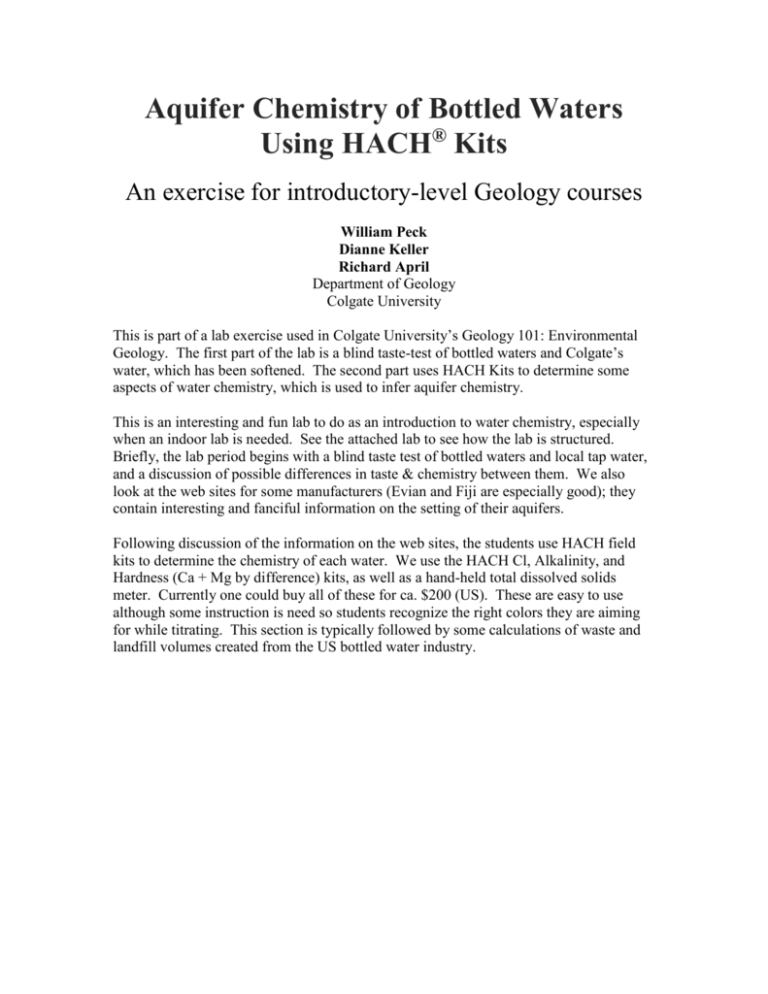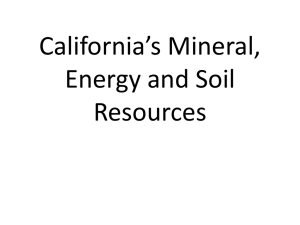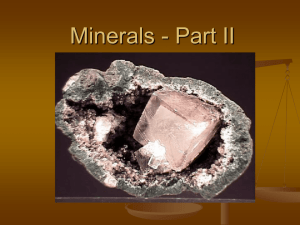Aquifer Chemistry of Bottled Waters Using HACH
advertisement

Aquifer Chemistry of Bottled Waters Using HACH® Kits An exercise for introductory-level Geology courses William Peck Dianne Keller Richard April Department of Geology Colgate University This is part of a lab exercise used in Colgate University’s Geology 101: Environmental Geology. The first part of the lab is a blind taste-test of bottled waters and Colgate’s water, which has been softened. The second part uses HACH Kits to determine some aspects of water chemistry, which is used to infer aquifer chemistry. This is an interesting and fun lab to do as an introduction to water chemistry, especially when an indoor lab is needed. See the attached lab to see how the lab is structured. Briefly, the lab period begins with a blind taste test of bottled waters and local tap water, and a discussion of possible differences in taste & chemistry between them. We also look at the web sites for some manufacturers (Evian and Fiji are especially good); they contain interesting and fanciful information on the setting of their aquifers. Following discussion of the information on the web sites, the students use HACH field kits to determine the chemistry of each water. We use the HACH Cl, Alkalinity, and Hardness (Ca + Mg by difference) kits, as well as a hand-held total dissolved solids meter. Currently one could buy all of these for ca. $200 (US). These are easy to use although some instruction is need so students recognize the right colors they are aiming for while titrating. This section is typically followed by some calculations of waste and landfill volumes created from the US bottled water industry. Average chemistries for the waters we use are below (all are bottled waters except the Hamilton NY tap water, which is softened). Even with typical operator error there are obvious differences between the waters, which can lead into discussion and analysis of mineral chemistry, mineral solubility, aquifer types, and EPA thresholds. 1000 100 Evian (Mg/L) Poland Spring Hamilton NY Fiji 10 Aquafina 1 TDS Alk Ca Mg Cl Evian Poland Spring Fiji Aquafina Carbonate aquifer (high TDS and Alkaline) Granitic aquifer (lower TDS) Mafic Aquifer (moderate TDS) Purified (low everything) Hamilton NY Carbonate aquifer, softened (high TDS, low Mg, high Cl) Name_________________________________ Geology 101: Environmental Geology Lab #7– Drinking Water and Aquifer Chemistry Introduction Today we will be comparing tap water to bottled water, which has been a booming industry in the U.S. for a few decades. We will perform a series of tests on a variety of waters to assess not only taste preferences but also differences in chemistry. Using the chemical data, we will determine the source and identity of five unknown samples. Finally, we will consider one environmental impact of this industry, the increased amount of solid waste generated by packaging material. Taste Tests Several numbered stations have been set up around the room, each with plastic cups containing a water sample from one bottled or local tap water source. Go to each station, judge the quality and fill out the taste test questionnaire for each sample. Tally your results below by listing each sample number (not the number of samples) under the appropriate ranking. Excellent Good Poor 1.) After the true identities of the samples are revealed, briefly comment on the results. Were you surprised by any of the choices you made? Why or why not? Water Analyses 1.) Each group will be assigned a few samples to analyze for a variety of chemical properties and constituents. Each person within the group should take a sample to analyze - each person within your group should be analyzing a different unknown. For each sample, fill in the corresponding table with your data, and with data collected by the other groups. Note which water you think it is in the space provided. Answer the questions to show how the chemistry relates to the sample identification you made. Sample TDS (mg/L) Alkalinity (mg/L) Ca (mg/L) Mg (mg/L) Cl (mg/L) A B C D E Rank the Waters 2.) Determine a relative ranking for the samples with respect to each of the chemical parameters that we tested and place the sample letters into the appropriate column below. This should help you with your determinations of each sample's identity. Lowest to Highest TDS (mg/L) Alkalinity (mg/L) Ca (mg/L) Mg (mg/L) Cl (mg/L) Determination of Sample Identities Sample A 1.) What does the TDS value suggest about the solubility of the minerals in source area of this water? 2.) What does the alkalinity value suggest about the type of the minerals in source area of this water? 3.) Based on your answers above - type of bedrock in the sourceland: ____________________________ 4.) How high are the Ca and Mg values? What mineral(s) likely provided them to this water? 5.) How high are the Cl values? What does this suggest? Identity of A ___________________________________________ Sample B 1.) What does the TDS value suggest about the solubility of the minerals in source area of this water? 2.) What does the alkalinity value suggest about the type of the minerals in source area of this water? 3.) Based on your answers above - type of bedrock in the sourceland: ____________________________ 4.) How high are the Ca and Mg values? What mineral(s) likely provided them to this water? 5.) How high are the Cl values? What does this suggest? Identity of B ___________________________________________ -------------------------------------------------------------------Sample C 1.) What does the TDS value suggest about the solubility of the minerals in source area of this water? 2.) What does the alkalinity value suggest about the type of the minerals in source area of this water? 3.) Based on your answers above - type of bedrock in the sourceland: ____________________________ 4.) How high are the Ca and Mg values? What mineral(s) likely provided them to this water? 5.) How high are the Cl values? What does this suggest? Identity of C ___________________________________________ Sample D 1.) What does the TDS value suggest about the solubility of the minerals in source area of this water? 2.) What does the alkalinity value suggest about the type of the minerals in source area of this water? 3.) Based on your answers above - type of bedrock in the sourceland: ____________________________ 4.) How high are the Ca and Mg values? What mineral(s) likely provided them to this water? 5.) How high are the Cl values? What does this suggest? Identity of D ___________________________________________ -------------------------------------------------------------------Sample E 1.) What does the TDS value suggest about the solubility of the minerals in source area of this water? 2.) What does the alkalinity value suggest about the type of the minerals in source area of this water? 3.) Based on your answers above - type of bedrock in the sourceland: ____________________________ 4.) How high are the Ca and Mg values? What mineral(s) likely provided them to this water? 5.) How high are the Cl values? What does this suggest? Identity of E ___________________________________________ Understanding Water Analyses Bottled water generally is collected from either springs emerging from the ground where the water table intersects the ground surface, or from wells drilled into subsurface aquifers (porous and permeable rock or sediment layers that easily transmit fluids). Rocks and sediments have a strong influence on the chemistry of water passing through them; so by performing a series of chemical tests, you should to be able to match a water sample to its source. pH - “potential for hydrogen” - measures the concentration of free H+ ions = ACIDITY Less than 7 = ACIDIC => interaction is with noncarbonate minerals like quartz and feldspars 7 = NEUTRAL => interaction ~easily weathered noncarbonates or carbonates, or purified Greater than 7 = BASIC => likely interaction with carbonates (Each unit increase in pH represents a 10-fold increase in the number of free H+ ions in the solution) Alkalinity = ACID NEUTRALIZING CAPACITY - the concentration of ionic species that can complex with free H+ ions, thereby taking them out of solution. CO32- (carbonate ion) and HCO31- (bicarbonate ion) are the best at doing this. The best source of these ions is the weathering of carbonate minerals like calcite and dolomite, although weathering reactions between carbonic acid and silicates can also be a source. Values greater than 150 probably => carbonates Values between ~30 - 150 probably => ~ soluble noncarbonates Values less than ~30 probably => ~ insoluble noncarbonates or purification TDS & Individual ions These will be highest when: **1) minerals in the ground are easily dissolved (i.e., have high solubilities- e.g., salts > carbonates > silicates) 2) water has a lot of time in contact with the minerals (water flows deeper beneath the surface (long path) rather than shorter, shallower paths). 3) materials have a lot of surface area exposed (small grains -eg., sediments & soils > than rocks) TDS = TOTAL DISSOLVED SOLIDS - all the ions in solution in water other than the H2O itself. If value is close to zero => probably purified Individual ions - depend on the chemistry of the minerals present and how soluble they are: Ca (calcium) & Mg (magnesium) - abundant in carbonates such as calcite and dolomite, and Mafic silicates such as Plagioclase (feldspar), olivine, pyroxene and hornblende. Na (sodium) & Cl (Chlorine) - abundant in halite (salt - e.g., road salt, water softener), and can be a component of some silicates such as placgioclase and hornblende. Chlorine is also added for water purification. Some important mineral compositions FYI: calcite - CaCO3 Plagioclase - (Ca,Na)(SiAl)4Si2O8 pyroxene - (Ca,Fe,Mg)Si2O6 hornblende - (Ca,Na)2-3(Mg,Al,Fe)5Si6(Si,Al)2O22(OH)2 dolomite - CaMg(CO3)2 halite - NaCl






